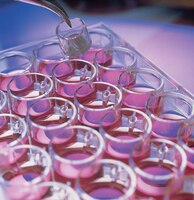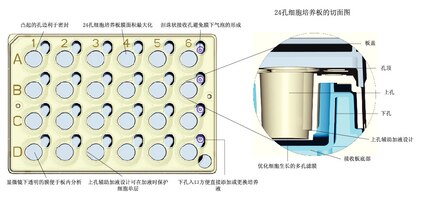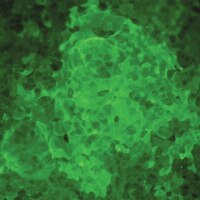Millicell® 24孔细胞培养板
Recommended Products
概述
规格
订货信息
Documentation
参考
| 参考概述 | 应用 |
|---|---|
| Propagation of human embryonic stem cells in a microporous membrane-based indirect co-culture system Kelsey Albert, Steven Sheridan, Louise Laurent, Igor Ulitsky, Ron Shamir, Jeanne Loring, & Raj R. Rao Biochemical and Biophysical Research Communications 2010 | |
| Effects of cimetidine on the biological behaviors of human gastric cancer cells Jiang CG, Liu FR, Xu HM, Wu T, Gao J. Zhonghua Yi Xue Za Zhi. 2006 Jul 11;86(26):1813-6 2006 | |
| Overexpression of TIMP-1 mediated by recombinant adenovirus in hepatocellular carcinoma cells inhibits proliferation and invasion in vitro Xia D, Yan LN, Xie JG, Tong Y, Yan ML, Wang XP, Zhang MM, Zhao LY. Hepatobiliary Pancreat Dis Int. 2006 Aug;5(3):409-15. 2006 | |
| Glucose utilization by the retinal pigment epithelium: evidence for rapid uptake and storage in glycogen, followed by glycogen utilization. Senanayake P, Calabro A, Hu JG, Bonilha VL, Darr A, Bok D, Hollyfield JG. Exp Eye Res. 2006 Aug;83(2):235-46. Epub 2006 May 11. 2006 | Cell Culture |
| Development of mouse embryos co-cultured with polarized or non-polarized uterine epithelial cells using sequential culture media. Azadbakht M, Valojerdi MR, Mowla SJ. Anim Reprod Sci. 2006 Jul 27 2006 | Cell Culture |
| Astrocyte growth effects of vascular endothelial growth factor (VEGF) application to perinatal neocortical explants: Receptor mediation and signal transduction pathways Nina Mani, Alfia Khaibullina, Janette Krum and Jeffrey Rosenstein Experimental Neurology 192 (2005); 394-406 2005 | Cell Culture |
| Subcellular localisation of recombinant a and g-synuclein Christian Specht, Cezar Tigaret, George Rast, Agnea Thalhammer, York Rudhard and Ralf Schoepfer Mol. Cell. Neurosci., 28 (2005); 326-334 2005 | Cell Culture |
| Establishment of the organotypic model of amyotrophic lateral sclerosis from the SD rats' spinal cord Diao ZY, et. al,Beijing Da Xue Xue Bao. 2005 Apr 18;37(2):134-8. Chinese. Beijing Da Xue Xue Bao. 2005 Apr 18;37(2):134-8. Chinese. 2005 | Cell Culture |
| A comparison of polarized and non-polarized human endometrial monolayer culture systems on murine embryo development. Baghaban Eslami Nejad MR, Rezazadeh Valojerdi M, Kazemi Ashtiani S. J Exp Clin Assist Reprod. 2005 Apr 19;2(1):7. 2005 | Cell Culture |
| Neural stem cells protect against glutamate-induced excitotoxicitiy and promote survival of injured motor neurons through the secretion of neurotrophic factors Jeronia Llado, Christine Haenggeli, Nicholas Maragakis, Evan Snyder and Jeffrey Rothstein Mol. Cell. Neurosci. , 27 (2004); 322-331 2004 | Cell Culture |
问与答
| 问题 | 回答 |
|---|---|
| Can cells grown on Isopore (polycarbonate) membrane be viewed under a microscope? | Yes, we can observe the cells seeding on the membrane of pore size 1 um. |
| Can I make membrane potential measurements with the Millicell-ERS? | Yes, membrane potential measurements can be made with the ERS. Short circuit potential, however, cannot be done. |
| How can I be sure that I have a confluent monolayer in my Millicell ? | There are several answers to this question based on the type of membrane you are using and the equipment you have. It is possible to view, via phase contrast microscopy, actual cell layers if you are using Millicell HA, PC and PCF. With Millicell CM you can use bright field microscopy as well to check for confluency. Also, one way of assuring confluency is to seed your cells at optimal levels. Most cell lines do best at a density of 5x10^5 to 1x10^6 cells/ cm2. So long as you are working with a cell type (i.e. epithelial cells) that exhibits resistance due to membrane potential you can also use the Millicell ERS to confirm confluency. |
| How long do the electrodes last? | The electrodes will last at least 6 months with normal use and care, barring any physical damage. To prolong life of the electrodes, clean after every use and store dry. |
| How should I store electrodes when not in use? | When storing electrodes for long periods of time, wash the electrodes with Milli-Q water or equivalent to remove salts and proteins, then store dry. For short term storage electrodes can be stored in a buffered solution. Make sure the electrode cable plug is connected to the electrode port on the Millicell ERS meter so that the system is internally short-circuited and electrode symmetry is maintained. |
| I am coating the Millicell CM with Rat Tail collagen according to your instructions and sometimes I am seeing an empty ring at the periphery of the insert where the collagen has not filled in and an empty "hole" at the center where there is no coating either. How can I avoid this from happening in the future? | If you are using Type 1 collagen, it should be filter sterilized in non-denaturing alcohol prior to use in the Millicell. Also, try looking at the insert while you are coating it and tap/rotate it to enhance uniform liquid coating. The entire membrane should go clear which indicates uniform wetting/coverage of the Millicell. Also, be sure to use at least minimum volumes of 50ul for the 12mm and 350 ul per 30 mm. |
| I am concerned about the possibility of introducing surfactants in cell cultures using the Millicell PCF product. Is the Polycarbonate membrane in Millicell-PCF PPVP (surfactant) free? | Yes, the Polycarbonate membrane in Millicell-PCF is PPVP (surfactant) free. |
| I have seeded cells on the Millicell and they are detaching from the membrane, what do I do to correct this? | Make sure that the medium on the outside of the insert is lower than the level of medium on the inside of the insert. Also, if it is important to remember that certain cells lines, i.e. attachment dependent cells, often require pretreatment of the Millicell membrane in order to enhance attachment. This is usually accomplished through ECM coating...especially in the case of Millicell CM where coating is always required. Too much feeding of unconditioned media can also cause detachment in some cell types, e.g. caco-2. |
| Are the Millicell PCF inserts tissue culture treated on both sides of the membrane? | Yes, they are tissue culture treated on both sides of the membrane. This allows for attachment- dependent cell culture on both sides of the membrane. |
| Are the Millicell units sterile and, if so, how are they sterilized? | The Millicell units are sold sterile in individual blister packs. The HA and CM units are ETO sterilized and the PC and PCF are Gamma Irradiated. |











